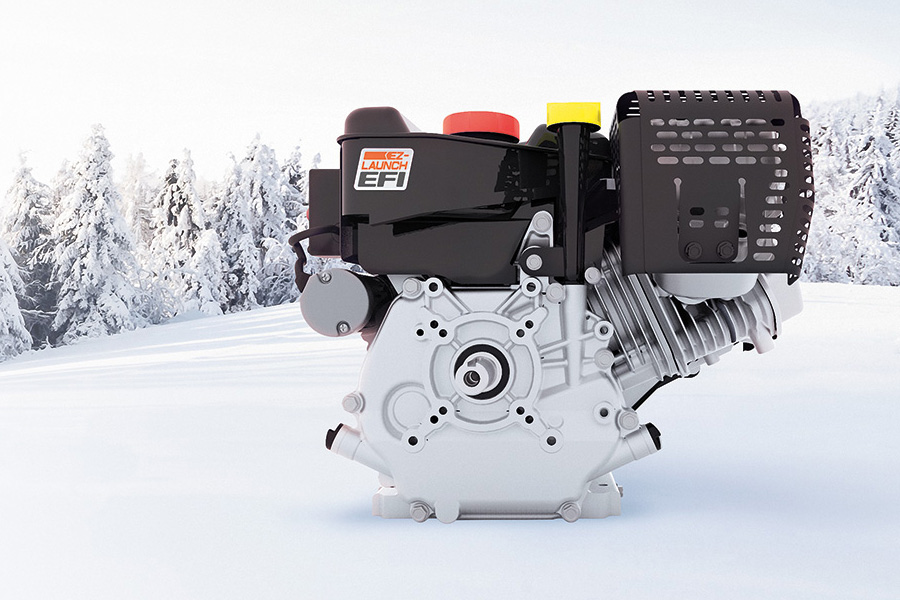Benefits of EFI Snow Blowers
12/4/2019 6:00:00 AM

Decades ago, a revolution driven by rising gas prices and stricter pollution standards swept through the automobile industry. Carburetors were out and more efficient electronic fuel injection (EFI) technology was in. Snow blowers are now experiencing that same changeover with EFI engines and offering a host of user benefits like increased power, reliability, efficiency, ease of use and more.
So what engines are in an Ariens snowblower? In addition to our traditional carbureted models, users now have the choice of EFI engines. Which is the best snow blower? That all depends on your application and if you think the benefits of EFI are a good fit for you.
What is electronic fuel injection?
Certain conditions and a precise sequence of events are required for combustion to occur inside an engine. Among those are the correct mixtures of fuel and oxygen. For years, regulating that sensitive fuel-to-air ratio in snow blower engines was reliant on carburetors. But with advances in technology, that job is also accomplished with EFI technology.
The air and fuel mixture inside EFI engines are regulated by a small computer known as the engine control unit, or ECU, which is the brain of the EFI system. The ECU receives information from sensors throughout the system to keep the engine running at a consistent power level with optimal efficiency, while also logging data that can be used in diagnosing problems quickly and accurately when service is needed.
EFI snow blower engines offer numerous benefits to consumers. We listed six of EFI’s top advantages and described them below:
EFI engines are easier to start
A major benefit of EFI systems is their cold- and hot-starting performance. When carbureted engines are cold, meaning they haven’t been run for about at least 30 minutes to one hour, they need to be choked and primed. With no fuel left in the carburetor, this requires the user to choke the engine, which restricts airflow to the carburetor, and to push the primer bulb to add fuel to the carburetor manually. It’s not a difficult task, but it’s sometimes tricky knowing the right amount to choke and prime the engine for it to start. EFI systems remove this complexity completely.
Due to the ECU’s ability to calculate the optimum air-to-fuel mixture for hot or cold starting, there’s no choking or priming with an Ariens EFI engine. That’s why it’s called EZ-Launch™, because it’s easy for the user. All you need to do is turn the key and pull the recoil starter handle or push the electric start button – no matter what temperature or altitude your engine is sitting at.

EFI engines are more powerful
Electronic fuel injected engines can provide more power and torque than their carbureted counterparts. As we already discussed, they optimize fuel and air ratios, and ignition timing while compensating for other factors to maintain continuous optimum performance. This makes EFI snow blowers some of the best snow blowers for wet snow.
EFI engines save fuel and have lower emissions
The snow blower engine ECU constantly monitors and adjusts the air-to-fuel ratio to maintain optimal combustion conditions and determines the precise amount of fuel that the injector needs to deliver. In simple terms, it only uses as much gasoline as it needs. Fuel consumption varies from engine to engine, but fine tuning the delivery reduces fuel consumption of an EFI engine compared to a carbureted engine.
EFI engines work better in the mountains
How carbureted engines work in high altitudes
Carbureted engines are naturally aspirated, meaning their oxygen intake is unassisted and controlled by atmospheric pressure, which changes at varying altitudes. This means that a carbureted engine’s air intake ability is entirely dependent on the oxygen content of the environment it’s working in. Atomic density, or the quantity of oxygen, nitrogen, hydrogen and other gases in the Earth's atmosphere, decreases as elevation increases. In fact, air density drops by one-third every 10,000 feet above sea level. This makes a snow blower engine work harder to create combustion in places like Denver (elevation: 5,280 feet) than it would at Boston’s elevation of 141 feet.
Think of engines like humans. As a mountain climber ascends Mount Everest, they breathe harder to compensate for the reduced amounts of oxygen pulled in with each breath. Carbureted engines work the same way. Engines compensate for less air by using more fuel to work harder, making them less efficient and causing them to run rich (use too much fuel) – bogging the engine down, causing it to stall or not start at all in higher elevations.
How EFI engines work in high altitudes
The ECU of an EFI engine knows the atmospheric pressure of its surroundings. When working in higher elevations like Appalachia, the Rockies, the Alps, the Sierra Nevada, etc., it adjusts its air intake to make the engine not only operate, but operate as efficiently as possible. This allows the engine to provide consistent power delivery and better fuel economy at varying altitudes with different oxygen densities.
EFI engines are more reliable
Carburetors can go out of adjustment
The possibility for random engine stops are greatly reduced in an EFI engine. If a traditional carbureted / non-EFI engine is primed too much before attempting a cold start, fuel can drip onto the spark plugs and foul them. This is commonly referred to as “flooding.” When flooded, spark plugs become grounded and don’t fire, meaning they can’t create the spark to ignite the fuel in an engine.
Flooding a carbureted engine can also result from a carburetor that’s out of adjustment. Though carbureted engines are set from the factory and usually don’t go out of adjustment, there’s always the chance they can, causing them to run rich with too much fuel.
Because there is no carburetor in an EFI engine, the potential for this issue to occur in an EFI engine is zero, providing users with more reliability and more assurance their machine won’t require the time and expense of maintenance or adjustments. It will help you answer the question of what is the most reliable snow blower brand.
EFI engines have less chance for fuel issues
We highlight this with every seasonal change. Whether you go from mower to blower or vise versa, Ariens emphasizes the importance of storing the fuel in your tank and fuel system correctly. If that critical step is avoided, fuel can oxidize, turn to a gel-like substance, clog the fuel lines and cause your engine to not start. It’s a common issue that far too many of our users learn the hard way, but it’s an issue that typically only applies to carbureted engines. As discussed above, carburetors mix air and fuel. But that oxygen, though necessary, is what causes fuel to go bad over a relatively short period of time.
EFI systems are different. With the absence of a carburetor, EFI fuel systems are sealed, meaning air doesn’t get into the system. Without air, fuel doesn’t oxidize, and if it doesn’t oxidize, the fuel system doesn’t get clogged. Just be aware that this isn’t a guarantee that fuel in an EFI system can’t go bad, it just means it has much less chance of oxidizing, clogging your fuel lines and costing you time and money in repairs.
EFI engines require less maintenance
Any combustion engine, carbureted or EFI, needs regular oil changes. That doesn’t change, but what does change is the amount of time spent preparing your unit for seasonal storage. As highlighted above, fuel in carbureted engines have a greater chance of deteriorating because oxygen gets into the fuel system. Users can help avoid fuel oxidation and clogging from happening in their carbureted engines by adding a quality fuel stabilizer to their fuel tank before storage, but it’s a careful process that takes time.
With EFI engines, there’s no need to take these precautions because EFI engines have sealed fuel systems. Air doesn’t get in, and if air doesn’t get in, fuel can’t oxidize and clog. Again, just remember that it’s not guaranteed. It is, however, much less likely to occur, and that cuts down on the times you take your engine in for service to resolve those fuel clogs that have greater chances of happening in carbureted engines.